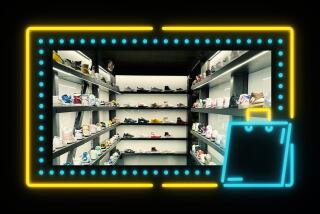Children’s Dress Shop Must Grow Into the Next Size
Now that her kids are growing up, designer Terri Becker has decided it’s time for her shop, Enchanted Child, to do so too.
The dress shop has always been what consultants call a “lifestyle business,” allowing Becker a creative outlet and time for her young children but not much in the way of money.
“Time is of the essence,” said Becker, 42, who opened the shop in downtown Covina near her kids’ school seven years ago. “If it doesn’t make money soon, then I need to drop it.”
Each year she sells about $65,000 worth of clothing for girls and women, mostly dresses. There are green and burgundy velvets in the winter. Pastel prints for summer and shimmery blue silks for special occasions. Dainty white christening gowns and lacy communion dresses are bestsellers for the shop, which gets three-quarters of its revenue from Becker’s own label, Enchanted Dress. Custom orders account for the rest.
Becker puts in 30 to 40 hours a week designing, cutting fabrics for her seamstress, sewing samples, selling in the shop, doing paperwork. Last year her take-home pay was $4,500.
“I might just as well be playing [at business], but I’m working too hard to call it playing,” Becker said.
Many small-business owners are stuck in the same situation, according to consultant John J. Rooney, president of Valley Economic Development Center Inc. They can pay the bills but can’t afford to pay themselves. To a business consultant, that’s a money-losing business.
“The bottom line is either you have to make a radical shift in your business or you’re going to have to close it,” said Rooney, who designed the entrepreneur training program used by his organization.
Even if Becker boosts sales by 30% a year, he said, she wouldn’t be able to earn the salary she believes is commensurate with the 20 years of experience she has in the fashion industry.
“That really shook her up,” said Rooney. “She thought, ‘If only I worked harder,’ and that’s not the case.” Becker can make only so many dresses by hand and her small retail store can attract only so many customers, he said. These limits on production and distribution will naturally be reflected in the sales volume.
Becker has two choices if she wants to meet her salary goal, he said. She can shutter her shop and find a design job at a clothing company, an option she has considered without much enthusiasm. Or she can increase distribution of her designs by selling them wholesale to other stores and high-end children’s catalogs, as well as on the Internet.
He recommended she try the second option.
“Her No. 1 strategy should be to devise an aggressive wholesale strategy,” said Rooney. High-end stores such as Nordstrom, which had expressed interest in the christening and communion dresses in the past, should be targeted. If Becker can get her products “into the right catalog,” said Rooney, “she could make her business overnight.”
Rooney also recommended that Becker upgrade her Web site (https://www.lugani.com/enchantedchild) to allow online ordering, and to set up a toll-free telephone number.
*
All that’s not to say Becker should abandon her retail store. Rooney recognized that it’s “sort of an emotional touchstone” for her. And it can serve as an ongoing “focus group,” providing instant feedback on her designs. But she needs to put some of her old passion back into the business, Rooney said. As the years have gone by, Becker has let drop some of the clever local marketing she used to do. Fashion shows at local churches and schools, cable TV advertising and personal mailings to customers drew a strong response and a marketing award from the city of Covina. Resuming local marketing alone could boost sales an estimated 20% to 30% a year, Rooney said.
The store’s “shoe-box accounting” system also needs to go, said Rooney, who recommended QuickBooks Pro computer software. Basic personnel systems, including at-will employment agreements, are also needed. He planned to give her a free copy of Employer Plus, a computer software program that includes most of the forms a small business would need.
To help Becker get a jump-start on his recommendations, Rooney signed her up for his 10-week entrepreneur training program and waived the tuition. By the end of classes this month, she should have a better idea what it will take to shift to wholesale and whether she wants to put in the time and resources to do so.
“It’s almost starting anew,” Rooney acknowledged.
He estimated the shift could cost $10,000, including the new marketing materials the company would need. And it will certainly take more than the 30 or so hours a week Becker is now working. Even if she is successful in getting her products into other stores, in catalogs and on the Web, it could take three or four years before the company sold enough to generate a large salary for Becker.
Becker herself has doubts about wholesale. At this point, only her christening gowns and communion dresses have the cost structure needed to be profitable at the wholesale level. She’s also worried that she’d have to move production to Mexico to be able to keep her prices low enough to appeal to big wholesalers.
And, as she learned during a recent fruitless effort to meet with buyers at several big companies, she may not have the contacts and professional sales experience needed to land wholesale accounts easily on her own.
“The more I’m thinking about it, in terms of personal preference, I’m thinking I would be happier expanding my retail base but not having to expand space-wise, by selling directly to the consumer online,” said Becker.
She’s tried four ideas to increase sales since she started the entrepreneur classes. Except for her failed effort to meet with store buyers, the ideas have begun to pay off, Becker said.
She hired a woman with a marketing background to market her christening gowns and communion dresses a few hours each week to local schools and churches.
She’s created a teen section in her store, with input from her 13-year-old daughter, to try to hold on to her young customers who are leaving childhood but don’t yet need adult clothing. Becker didn’t have time to design or make the items but chose “soft, feminine” dresses, capri pants and blouses that match the look of the rest of the store, she said.
*
Becker has put much of her time into updating her Web site. Customers can now view some dresses and order online. She’s added a toll-free telephone number, which is posted on her Web site. She’s picked up three orders for the christening dress. It’s a small start, but exciting, Becker said.
She may not reach her salary goal immediately, particularly if she doesn’t succeed selling wholesale. But just getting a sales-growth curve started would be “extremely motivating,” Becker said.
Once she actually turns a serious profit, Rooney said, “then it will really start to get exciting.”
(BEGIN TEXT OF INFOBOX / INFOGRAPHIC)
This Week’s Company Make-Over
* Name: Enchanted Child
* Headquarters: Covina
* Type of business: Retail shop specializing in girls’ and women’s clothing designed by the owner
* Status: Sole proprietor
* Owner: Terri Becker
* Founded: June 1992
* Start-up financing: $10,000 of personal savings
* 1998 sales: $65,000
* Employees: Two part-time
* Customers/clients: Mostly local women buying retail or ordering custom-madedresses for girls or women
Main Business Problem
Low sales, limited distribution, need for growth
Goal
Sales that support a salary for the owner commensurate with her experience and skills, perhaps $100,000 annually
Recommendations
* Consider reinventing the business as a wholesale distributor of clothing designed by the owner.
* Create a business plan and a marketing plan to put products into Nordstrom and other high-end retailers, upscale children’s clothing catalogs and on the Internet.
n Decide whether to pursue wholesale distribution, keep store as an unprofitable but enjoyable “lifestyle business” or close up shop and get an outside job as a designer.
Meet the Consultant
John J. Rooney, president of Valley Economic Development Center Inc. for the last five years, designed the entrepreneur training program offered by the Sherman Oaks organization, which also provides small-business consulting and financing.
More to Read
Inside the business of entertainment
The Wide Shot brings you news, analysis and insights on everything from streaming wars to production — and what it all means for the future.
You may occasionally receive promotional content from the Los Angeles Times.










